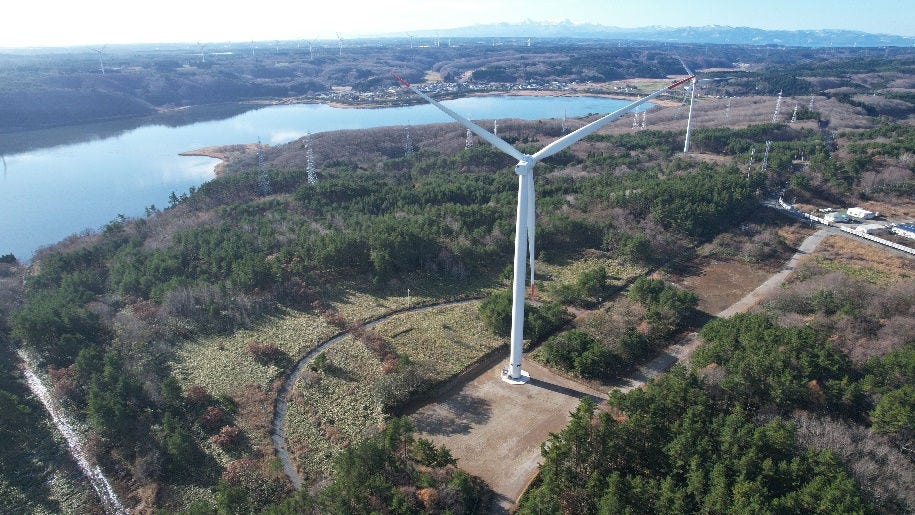New-Mutsu-Ogawara Wind Farm Commences Commercial Operations
July 1, 2025
Cosmo Energy Holdings Co., Ltd.
Cosmo Eco Power Co., Ltd.
Cosmo Eco Power Co., Ltd., a subsidiary of Cosmo Energy Holdings Co., Ltd., announced that New-Mutsu-Ogawara Wind Farm (hereafter, “the Power Plant”), which it has been rebuilding since April 2023, commenced commercial operations under Japan’s FIP scheme1, starting on July 1, 2025.
The Power Plant operated commercially as Mutsu-Ogawara Wind Farm for 20 years, from January 2003 to March 2023, but was temporarily shut down in order to undergo reconstruction work. Thanks to newfound support from the local community, landowners, and Rokkasho Village in Kamikita District, Aomori Prefecture, reconstruction work has been completed, and the Power Plant has resumed commercial operations as New-Mutsu-Ogawara Wind Farm with newly installed wind power generation facilities.
Rokkasho Village, where the Power Plant is located, is one of Japan’s most suitable sites for wind power generation due to its consistently stable winds throughout the year. It is also situated within the Mutsu-Ogawara Development Area, with numerous facilities related to Japan's energy infrastructure, including the national petroleum stockpiling base, located nearby.
Cosmo Eco Power has signed a 20-year corporate Power Purchase Agreement (PPA) with Amazon to supply renewable energy generated at New-Mutsu-Ogawara Wind Farm, and transactions began simultaneously with the start of operations. As part of its global commitment to achieve net zero carbon emissions across its operations by 2040, Amazon continues to invest in carbon-free energy projects around the world. In Japan, Amazon has invested in 25 renewable energy projects to date, and this project will be its first onshore wind project in the country.
Through its wind power generation business, Cosmo Eco Power will continue to pursue various initiatives in collaboration with the local community, all while considering regional development and staying true to its corporate mission: “We will promote a lasting, eco-friendly society by contributing to the spread of renewable energy.”

(New-Mutsu-Ogawara Wind Farm)
Overview of the Power Plant
| Power plant name | New-Mutsu-Ogawara Wind Farm |
|---|---|
| Location | Rokkasho Village, Kamikita District, Aomori Prefecture |
| Capacity | 33MW (4.3MW×8 turbines, output curtailed by a park control system) |
Going forward, the Cosmo Energy Group remains committed to achieving net zero carbon emissions by 2050 through a range of initiatives, including expanding its wind power generation business.
1. Feed-in Premium (FIP) scheme: A program established in April 2022 to further promote renewable energy adoption and establish it as Japan’s main power source. Under this scheme, power producers receive a premium on top of the revenue earned from selling electricity. Unlike the conventional Feed-in Tariff (FIT) scheme2, where electricity generated at power plants is purchased by electric power companies, the FIP scheme allows power producers to choose their buyers, including sales to the wholesale electricity market or direct transactions with consumers via corporate PPAs, etc.
2. Feed-in Tariff (FIT) scheme: Under this program, which was enacted in 2012 with the goal of promoting the adoption of renewable energy, the Japanese government guarantees that electric power companies can purchase electricity generated from renewable energy sources at a fixed price for a certain period. A portion of the electricity purchase cost is covered by the public through a renewable energy surcharge.
(End)
(The official language for Cosmo Energy Group's filings with the Tokyo Stock Exchange and Japanese authorities, and for communications with our shareholders, is Japanese. We have posted English versions of some of this information on this website. While these English versions have been prepared in good faith, Cosmo Energy Group does not accept responsibility for the accuracy of the translations, and reference should be made to the original Japanese language materials.